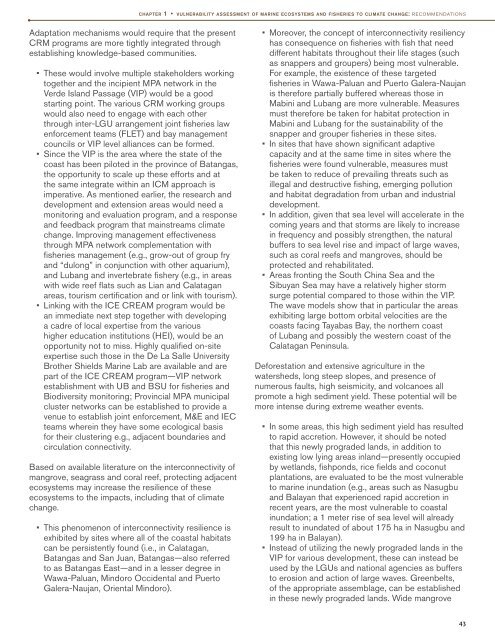of the Verde Island Passage, Philippines - weADAPT
of the Verde Island Passage, Philippines - weADAPT
of the Verde Island Passage, Philippines - weADAPT
Create successful ePaper yourself
Turn your PDF publications into a flip-book with our unique Google optimized e-Paper software.
chapter 1 • vulnerability assessment <strong>of</strong> marine ecosystems and fisheries to climate change: recommendations<br />
Adaptation mechanisms would require that <strong>the</strong> present<br />
CRM programs are more tightly integrated through<br />
establishing knowledge-based communities.<br />
• These would involve multiple stakeholders working<br />
toge<strong>the</strong>r and <strong>the</strong> incipient MPA network in <strong>the</strong><br />
<strong>Verde</strong> <strong>Island</strong> <strong>Passage</strong> (VIP) would be a good<br />
starting point. The various CRM working groups<br />
would also need to engage with each o<strong>the</strong>r<br />
through inter-LGU arrangement joint fisheries law<br />
enforcement teams (FLET) and bay management<br />
councils or VIP level alliances can be formed.<br />
• Since <strong>the</strong> VIP is <strong>the</strong> area where <strong>the</strong> state <strong>of</strong> <strong>the</strong><br />
coast has been piloted in <strong>the</strong> province <strong>of</strong> Batangas,<br />
<strong>the</strong> opportunity to scale up <strong>the</strong>se efforts and at<br />
<strong>the</strong> same integrate within an ICM approach is<br />
imperative. As mentioned earlier, <strong>the</strong> research and<br />
development and extension areas would need a<br />
monitoring and evaluation program, and a response<br />
and feedback program that mainstreams climate<br />
change. Improving management effectiveness<br />
through MPA network complementation with<br />
fisheries management (e.g., grow-out <strong>of</strong> group fry<br />
and “dulong” in conjunction with o<strong>the</strong>r aquarium),<br />
and Lubang and invertebrate fishery (e.g., in areas<br />
with wide reef flats such as Lian and Calatagan<br />
areas, tourism certification and or link with tourism).<br />
• Linking with <strong>the</strong> ICE CREAM program would be<br />
an immediate next step toge<strong>the</strong>r with developing<br />
a cadre <strong>of</strong> local expertise from <strong>the</strong> various<br />
higher education institutions (HEI), would be an<br />
opportunity not to miss. Highly qualified on-site<br />
expertise such those in <strong>the</strong> De La Salle University<br />
Bro<strong>the</strong>r Shields Marine Lab are available and are<br />
part <strong>of</strong> <strong>the</strong> ICE CREAM program—VIP network<br />
establishment with UB and BSU for fisheries and<br />
Biodiversity monitoring; Provincial MPA municipal<br />
cluster networks can be established to provide a<br />
venue to establish joint enforcement, M&E and IEC<br />
teams wherein <strong>the</strong>y have some ecological basis<br />
for <strong>the</strong>ir clustering e.g., adjacent boundaries and<br />
circulation connectivity.<br />
Based on available literature on <strong>the</strong> interconnectivity <strong>of</strong><br />
mangrove, seagrass and coral reef, protecting adjacent<br />
ecosystems may increase <strong>the</strong> resilience <strong>of</strong> <strong>the</strong>se<br />
ecosystems to <strong>the</strong> impacts, including that <strong>of</strong> climate<br />
change.<br />
• This phenomenon <strong>of</strong> interconnectivity resilience is<br />
exhibited by sites where all <strong>of</strong> <strong>the</strong> coastal habitats<br />
can be persistently found (i.e., in Calatagan,<br />
Batangas and San Juan, Batangas—also referred<br />
to as Batangas East—and in a lesser degree in<br />
Wawa-Paluan, Mindoro Occidental and Puerto<br />
Galera-Naujan, Oriental Mindoro).<br />
• Moreover, <strong>the</strong> concept <strong>of</strong> interconnectivity resiliency<br />
has consequence on fisheries with fish that need<br />
different habitats throughout <strong>the</strong>ir life stages (such<br />
as snappers and groupers) being most vulnerable.<br />
For example, <strong>the</strong> existence <strong>of</strong> <strong>the</strong>se targeted<br />
fisheries in Wawa-Paluan and Puerto Galera-Naujan<br />
is <strong>the</strong>refore partially buffered whereas those in<br />
Mabini and Lubang are more vulnerable. Measures<br />
must <strong>the</strong>refore be taken for habitat protection in<br />
Mabini and Lubang for <strong>the</strong> sustainability <strong>of</strong> <strong>the</strong><br />
snapper and grouper fisheries in <strong>the</strong>se sites.<br />
• In sites that have shown significant adaptive<br />
capacity and at <strong>the</strong> same time in sites where <strong>the</strong><br />
fisheries were found vulnerable, measures must<br />
be taken to reduce <strong>of</strong> prevailing threats such as<br />
illegal and destructive fishing, emerging pollution<br />
and habitat degradation from urban and industrial<br />
development.<br />
• In addition, given that sea level will accelerate in <strong>the</strong><br />
coming years and that storms are likely to increase<br />
in frequency and possibly streng<strong>the</strong>n, <strong>the</strong> natural<br />
buffers to sea level rise and impact <strong>of</strong> large waves,<br />
such as coral reefs and mangroves, should be<br />
protected and rehabilitated.<br />
• Areas fronting <strong>the</strong> South China Sea and <strong>the</strong><br />
Sibuyan Sea may have a relatively higher storm<br />
surge potential compared to those within <strong>the</strong> VIP.<br />
The wave models show that in particular <strong>the</strong> areas<br />
exhibiting large bottom orbital velocities are <strong>the</strong><br />
coasts facing Tayabas Bay, <strong>the</strong> nor<strong>the</strong>rn coast<br />
<strong>of</strong> Lubang and possibly <strong>the</strong> western coast <strong>of</strong> <strong>the</strong><br />
Calatagan Peninsula.<br />
Deforestation and extensive agriculture in <strong>the</strong><br />
watersheds, long steep slopes, and presence <strong>of</strong><br />
numerous faults, high seismicity, and volcanoes all<br />
promote a high sediment yield. These potential will be<br />
more intense during extreme wea<strong>the</strong>r events.<br />
• In some areas, this high sediment yield has resulted<br />
to rapid accretion. However, it should be noted<br />
that this newly prograded lands, in addition to<br />
existing low lying areas inland—presently occupied<br />
by wetlands, fishponds, rice fields and coconut<br />
plantations, are evaluated to be <strong>the</strong> most vulnerable<br />
to marine inundation (e.g., areas such as Nasugbu<br />
and Balayan that experienced rapid accretion in<br />
recent years, are <strong>the</strong> most vulnerable to coastal<br />
inundation; a 1 meter rise <strong>of</strong> sea level will already<br />
result to inundated <strong>of</strong> about 175 ha in Nasugbu and<br />
199 ha in Balayan).<br />
• Instead <strong>of</strong> utilizing <strong>the</strong> newly prograded lands in <strong>the</strong><br />
VIP for various development, <strong>the</strong>se can instead be<br />
used by <strong>the</strong> LGUs and national agencies as buffers<br />
to erosion and action <strong>of</strong> large waves. Greenbelts,<br />
<strong>of</strong> <strong>the</strong> appropriate assemblage, can be established<br />
in <strong>the</strong>se newly prograded lands. Wide mangrove<br />
43
















